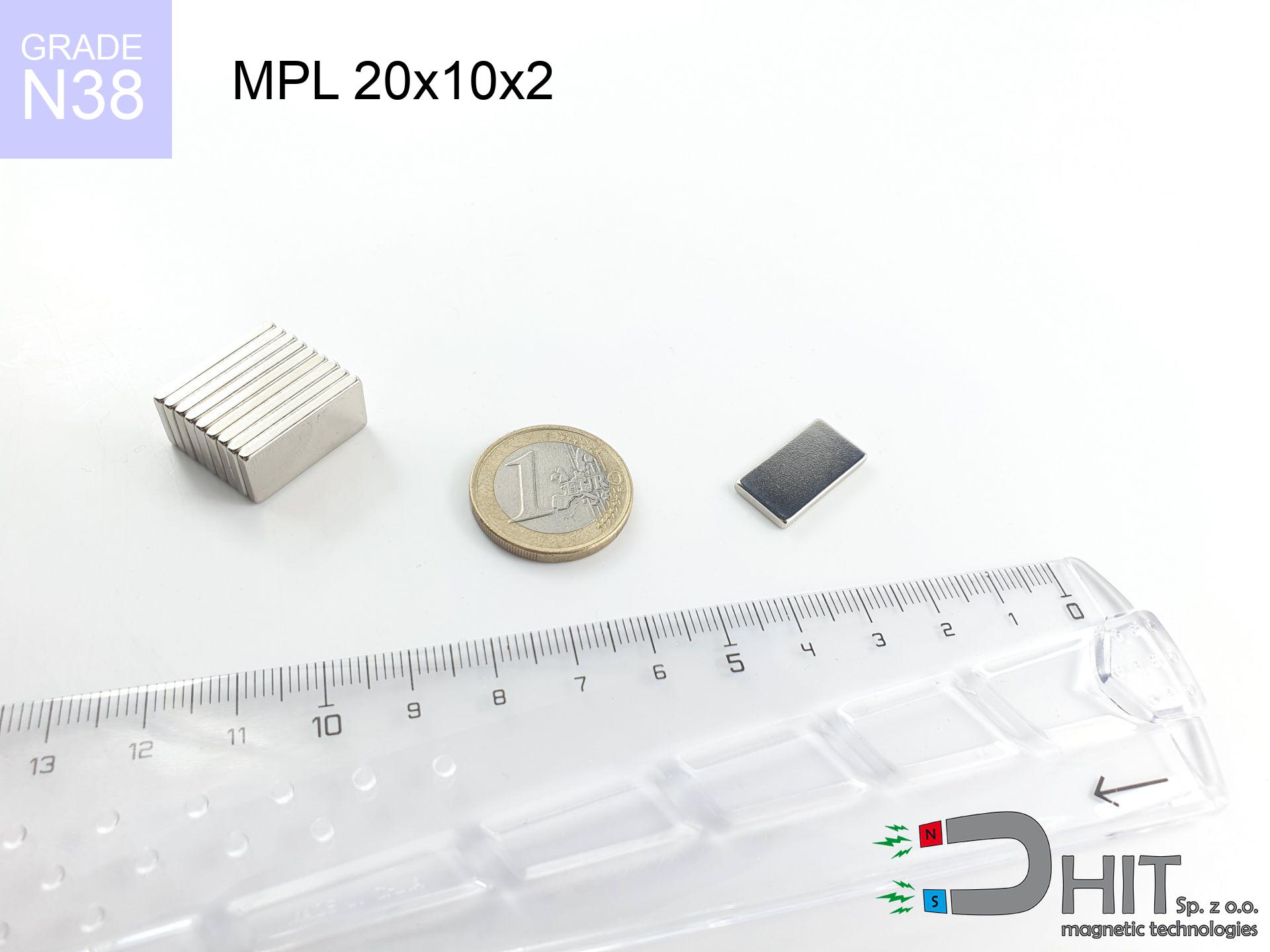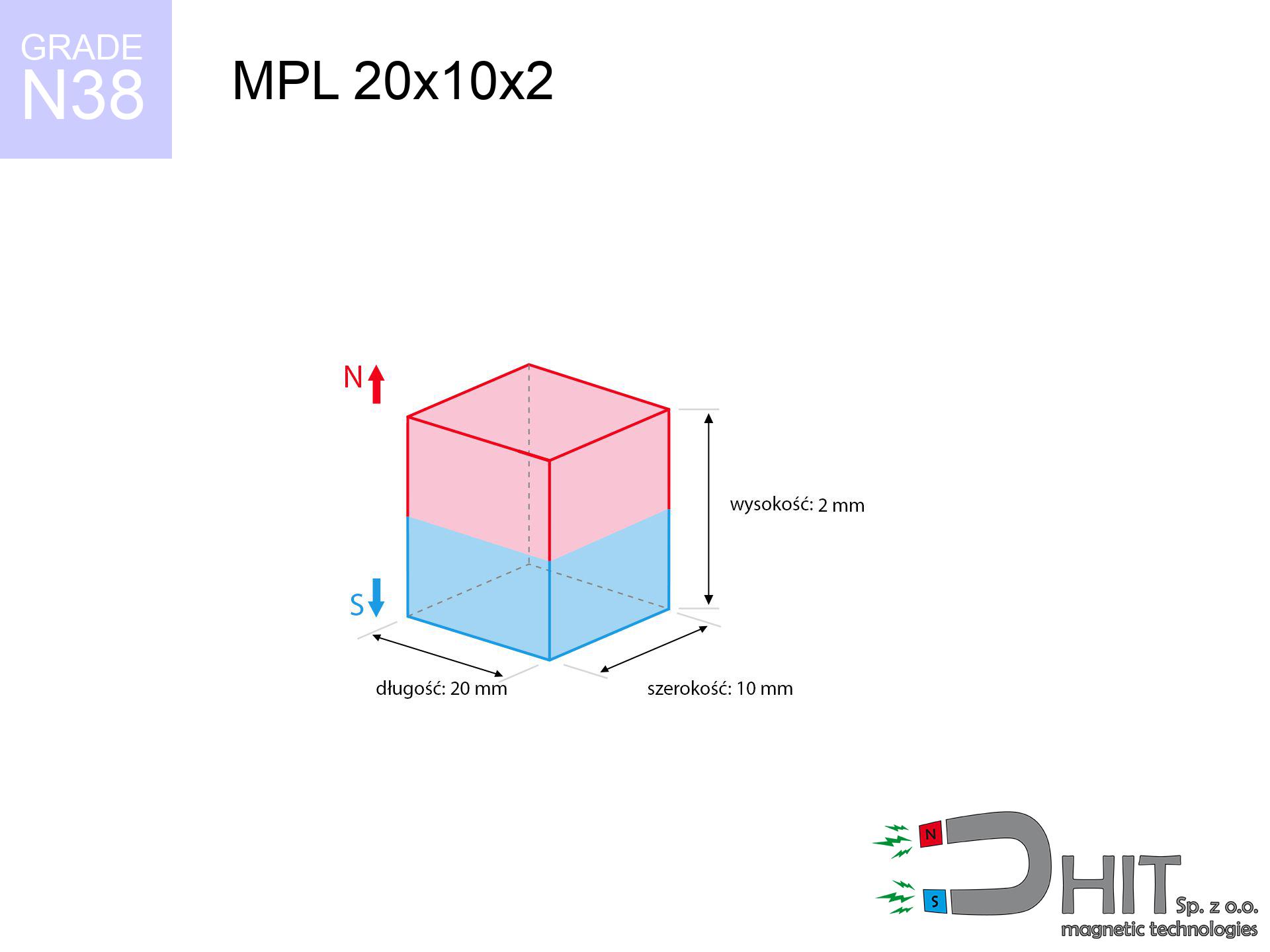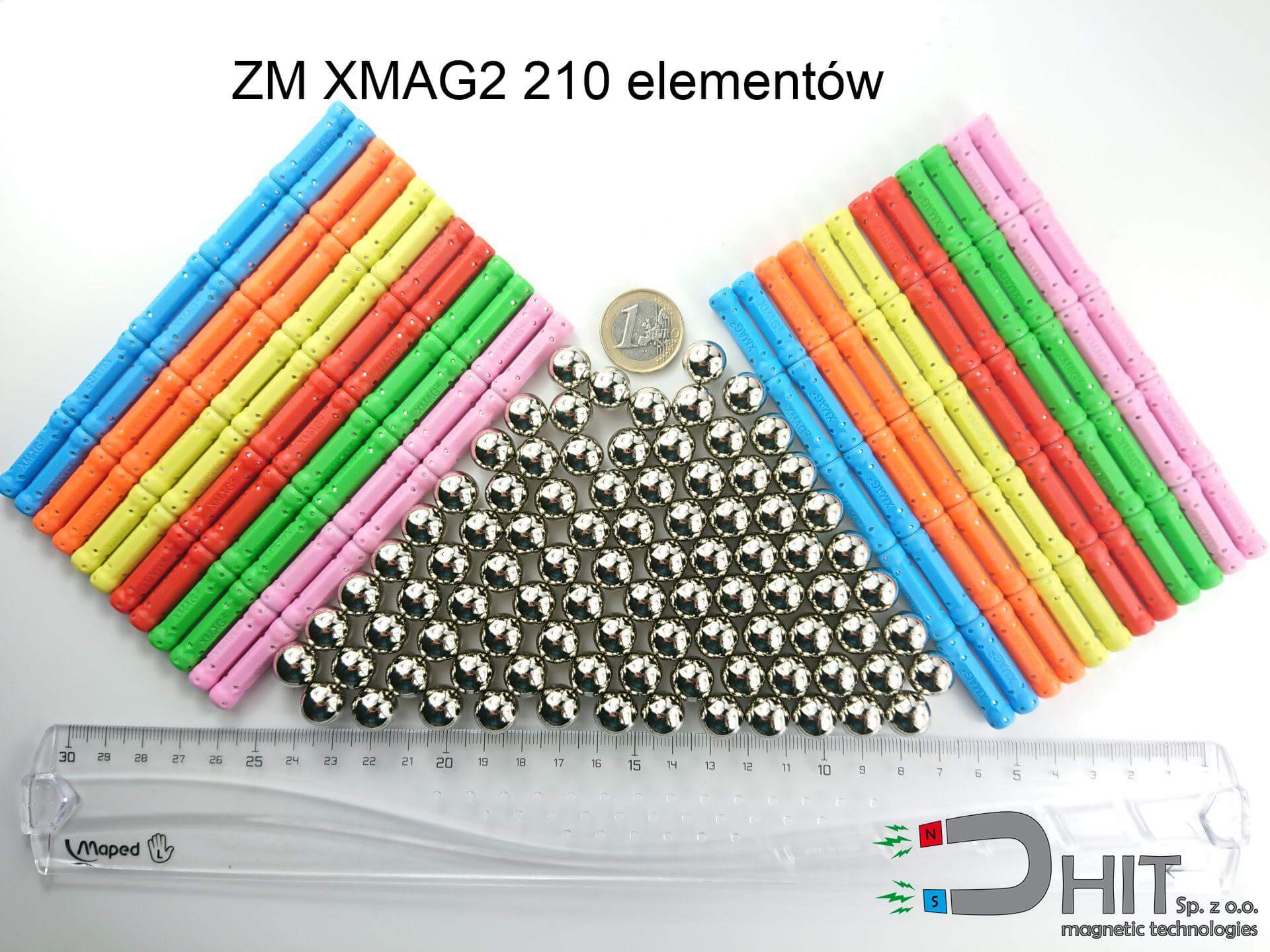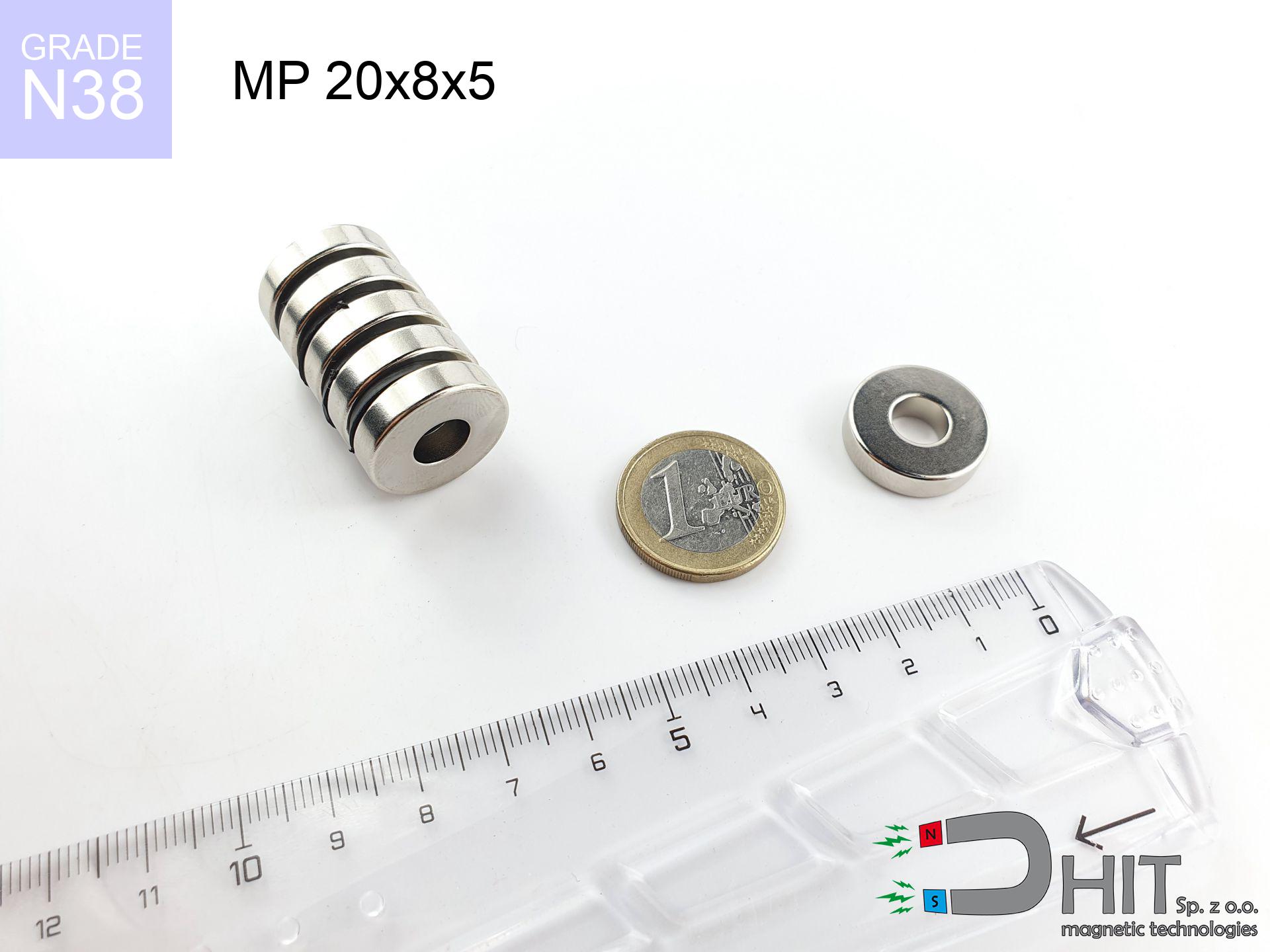MPL 20x10x2 / N38 - lamellar magnet
lamellar magnet
Catalog no 020127
GTIN: 5906301811336
length [±0,1 mm]
20 mm
Width [±0,1 mm]
10 mm
Height [±0,1 mm]
2 mm
Weight
3 g
Magnetization Direction
↑ axial
Load capacity
2.23 kg / 21.87 N
Magnetic Induction
168.24 mT
Coating
[NiCuNi] nickel
1.538 ZŁ with VAT / pcs + price for transport
1.250 ZŁ net + 23% VAT / pcs
bulk discounts:
Need more?Want to talk magnets?
Call us now
+48 22 499 98 98
alternatively drop us a message using
contact form
the contact page.
Strength along with structure of neodymium magnets can be tested on our
power calculator.
Same-day processing for orders placed before 14:00.
MPL 20x10x2 / N38 - lamellar magnet
Magnetic properties of material N38
Physical properties of NdFeB
Shopping tips
Thanks to their mighty power, flat magnets are commonly applied in structures that need strong holding power.
The standard temperature resistance of these magnets is 80°C, but depending on the dimensions, this value can increase.
Additionally, flat magnets often have special coatings applied to their surfaces, such as nickel, gold, or chrome, for enhancing their durability.
The magnet with the designation MPL 20x10x2 / N38 and a lifting capacity of 2.23 kg which weighs a mere 3 grams, making it the ideal choice for projects needing a flat magnet.
Contact surface: Due to their flat shape, flat magnets ensure a greater contact surface with adjacent parts, which is beneficial in applications needing a stronger magnetic connection.
Technology applications: These magnets are often used in many devices, e.g. sensors, stepper motors, or speakers, where the thin and wide shape is crucial for their operation.
Mounting: The flat form's flat shape makes it easier mounting, especially when it is necessary to attach the magnet to another surface.
Design flexibility: The flat shape of the magnets allows creators a lot of flexibility in arranging them in devices, which is more difficult with magnets of other shapes.
Stability: In some applications, the flat base of the flat magnet can provide better stability, minimizing the risk of sliding or rotating. However, it's important to note that the optimal shape of the magnet is dependent on the given use and requirements. In certain cases, other shapes, like cylindrical or spherical, are more appropriate.
Magnets have two poles: north (N) and south (S), which attract each other when they are oppositely oriented. Poles of the same kind, e.g. two north poles, repel each other.
Thanks to this principle of operation, magnets are often used in electrical devices, e.g. motors, speakers, sensors, or magnetic locks. Neodymium magnets stand out with the greatest strength of attraction, making them indispensable for applications requiring powerful magnetic fields. Additionally, the strength of a magnet depends on its size and the materials used.
It should be noted that high temperatures can weaken the magnet's effect. Every magnetic material has its Curie point, meaning that under such conditions, the magnet stops being magnetic. Additionally, strong magnets can interfere with the operation of devices, such as compasses, magnetic stripe cards or electronic devices sensitive to magnetic fields. For this reason, it is important to avoid placing magnets near such devices.
Advantages and disadvantages of neodymium magnets NdFeB.
Apart from their consistent power, neodymium magnets have these key benefits:
- They do not lose their strength approximately 10 years – the loss of lifting capacity is only ~1% (according to tests),
- They protect against demagnetization induced by ambient magnetic fields remarkably well,
- Thanks to the glossy finish and silver coating, they have an visually attractive appearance,
- They possess intense magnetic force measurable at the magnet’s surface,
- Neodymium magnets are known for strong magnetic induction and the ability to work at temperatures up to 230°C or higher (depending on the geometry),
- Thanks to the freedom in shaping and the capability to adapt to individual requirements, neodymium magnets can be created in different geometries, which expands their usage potential,
- Important function in cutting-edge sectors – they are utilized in HDDs, electric drives, medical equipment or even high-tech tools,
- Relatively small size with high magnetic force – neodymium magnets offer impressive pulling strength in tiny dimensions, which makes them useful in miniature devices
Disadvantages of rare earth magnets:
- They can break when subjected to a strong impact. If the magnets are exposed to physical collisions, it is suggested to place them in a protective enclosure. The steel housing, in the form of a holder, protects the magnet from breakage and additionally increases its overall resistance,
- They lose magnetic force at extreme temperatures. Most neodymium magnets experience permanent degradation in strength when heated above 80°C (depending on the geometry and height). However, we offer special variants with high temperature resistance that can operate up to 230°C or higher,
- Magnets exposed to wet conditions can oxidize. Therefore, for outdoor applications, we suggest waterproof types made of non-metallic composites,
- Using a cover – such as a magnetic holder – is advised due to the challenges in manufacturing fine shapes directly in the magnet,
- Possible threat related to magnet particles may arise, if ingested accidentally, which is crucial in the health of young users. It should also be noted that miniature parts from these devices may interfere with diagnostics when ingested,
- High unit cost – neodymium magnets are more expensive than other types of magnets (e.g., ferrite), which can restrict large-scale applications
Best holding force of the magnet in ideal parameters – what it depends on?
The given strength of the magnet represents the optimal strength, assessed in ideal conditions, specifically:
- with the use of low-carbon steel plate acting as a magnetic yoke
- with a thickness of minimum 10 mm
- with a polished side
- with no separation
- under perpendicular detachment force
- at room temperature
Key elements affecting lifting force
The lifting capacity of a magnet depends on in practice the following factors, from primary to secondary:
- Air gap between the magnet and the plate, because even a very small distance (e.g. 0.5 mm) can cause a drop in lifting force of up to 50%.
- Direction of applied force, because the maximum lifting capacity is achieved under perpendicular application. The force required to slide the magnet along the plate is usually several times lower.
- Thickness of the plate, as a plate that is too thin causes part of the magnetic flux not to be used and to remain wasted in the air.
- Material of the plate, because higher carbon content lowers holding force, while higher iron content increases it. The best choice is steel with high magnetic permeability and high saturation induction.
- Surface of the plate, because the more smooth and polished it is, the better the contact and consequently the greater the magnetic saturation.
- Operating temperature, since all permanent magnets have a negative temperature coefficient. This means that at high temperatures they are weaker, while at sub-zero temperatures they become slightly stronger.
* Holding force was checked on the plate surface of 20 mm thickness, when a perpendicular force was applied, whereas under shearing force the lifting capacity is smaller. In addition, even a minimal clearance {between} the magnet’s surface and the plate reduces the lifting capacity.
Handle Neodymium Magnets Carefully
Neodymium magnets can attract to each other, pinch the skin, and cause significant swellings.
Magnets will attract each other within a distance of several to about 10 cm from each other. Don't put your fingers in the path of magnet attraction, because a major injury may occur. Depending on how huge the neodymium magnets are, they can lead to a cut or alternatively a fracture.
Neodymium magnets can become demagnetized at high temperatures.
Although magnets have demonstrated their effectiveness up to 80°C or 175°F, the temperature can vary depending on the type, shape, and intended use of the specific magnet.
Do not place neodymium magnets near a computer HDD, TV, and wallet.
Strong magnetic fields emitted by neodymium magnets can damage magnetic storage media such as floppy disks, credit cards, magnetic ID cards, cassette tapes, video tapes, or other devices. They can also damage televisions, VCRs, computer monitors, and CRT displays. Avoid placing neodymium magnets in close proximity to electronic devices.
The magnet coating is made of nickel, so be cautious if you have an allergy.
Studies show a small percentage of people have allergies to certain metals, including nickel. An allergic reaction often manifests as skin redness and rash. If you have a nickel allergy, try wearing gloves or avoid direct contact with nickel-plated neodymium magnets.
Neodymium magnetic are fragile as well as can easily break and get damaged.
In the event of a collision between two neodymium magnets, it can result in them getting chipped. Despite being made of metal and coated with a shiny nickel plating, they are not as hard as steel. In the case of a collision between two magnets, there can be a scattering of small sharp metal fragments in different directions. Protecting your eyes is essential.
Dust and powder from neodymium magnets are flammable.
Avoid drilling or mechanical processing of neodymium magnets. Once crushed into fine powder or dust, this material becomes highly flammable.
Neodymium magnets should not be near people with pacemakers.
In the case of neodymium magnets, there is a strong magnetic field. As a result, it interferes with the operation of a heart pacemaker. Even if the magnetic field does not affect the device, it can damage its components or deactivate the entire device.
Never bring neodymium magnets close to a phone and GPS.
Magnetic fields can interfere with compasses and magnetometers used in aviation and maritime navigation, as well as internal compasses of smartphones and GPS devices. There are neodymium magnets in every smartphone, for example, in the microphone and speakers.
Do not give neodymium magnets to children.
Remember that neodymium magnets are not toys. Be cautious and make sure no child plays with them. Small magnets can pose a serious choking hazard. If multiple magnets are swallowed, they can attract to each other through the intestinal walls, causing significant injuries, and even death.
Neodymium magnets are among the most powerful magnets on Earth. The surprising force they generate between each other can shock you.
Please review the information on how to handle neodymium magnets and avoid significant harm to your body, as well as prevent unintentional disruption to the magnets.
Caution!
In order to show why neodymium magnets are so dangerous, see the article - How very dangerous are strong neodymium magnets?.






![SM 32x150 [2xM8] / N42 - magnetic separator SM 32x150 [2xM8] / N42 - magnetic separator](https://cdn3.dhit.pl/graphics/products/sm-32x150-2xm8-xus.jpg)
![UMP 94x40 [3xM10] GW F550 Silver Black Lina / N52 - search holder UMP 94x40 [3xM10] GW F550 Silver Black Lina / N52 - search holder](https://cdn3.dhit.pl/graphics/products/ump-94x40-3xm10-gw-f550-lina-gub.jpg)

